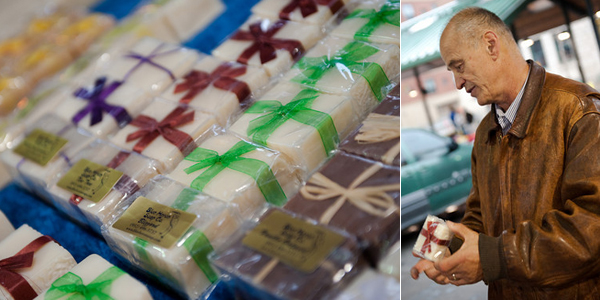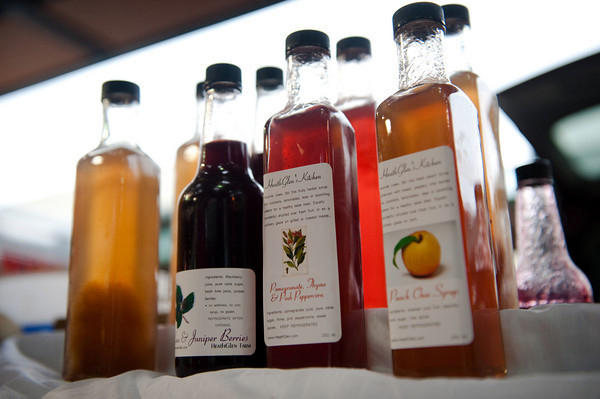
Don Heinel (above, right) needs to call home and ask his wife to send out a tweet: “We’ve already sold out of spinach & parsnips.” It’s 10 am on opening day at the Minneapolis Farmers Market on Lyndale Avenue, and his Heinel Farm spinach and spring onions were pretty much the only locally grown green items available.
Up and down the rows there are potted plants and bricks of cheese and freezers of pastured beef and chicken. There are also, truth be told, plenty of empty stalls and tables covered with wholesale bananas, zucchini, and peppers. There aren’t many customers at those tables: In late April and early May those imported treats look especially out of place. Who would brave the steady drizzle and occasional pounding bursts of rain for the same selection you find at Cub?
The earliest days of a Minnesota farmers market are more about anticipation than fulfillment. While I came home from opening day with a bag of spinach and some mushrooms and ramps — one eclectic spring dinner’s worth of goods — what I really went to the market to find was a little taste of the summer to come, days when I would invariably realize I hadn’t brought enough bags — or enough cash — and would have to choose between the beautiful berries and the perfect tomatoes.
Well, okay, honestly, what I truly went to the market to find was some rhubarb, asparagus, fiddleheads — those unapologetically seasonal now-you-see-them-now-you-don’t joys. But that just tells you something about the irrational hope brought on by a Minnesota spring. I’ll need to haunt the market for a month or so before my efforts are rewarded.
So it’s no wonder that Don Heinel’s over-wintered vegetables were so popular. Planted in the fall, he said, they survive just fine in the cold ground, even getting a little tastier as they freeze and thaw. Farmer Heinel, we thank you for your foresight. Next up he says he’ll have spring lettuces, beets, and zucchini, grown in low plastic-covered tunnels — another smart way to extend the Upper Midwest growing season.
A fourth-generation farmer, Heinel says he enjoys the immediate feedback and appreciation he gets from customers at the farmers market. “I used to wholesale,” he says, “but it’s really ungrateful work. It’s all about price, not about a quality product.” And, on cue, a young woman steps up to his table, slips her iPhone into her bag, and tells Heinel she’s just used up the last of the squashes she bought from him in the fall. “The cat didn’t get them?” he asks. “No!” she laughs.
“See: This is a great place to sell,” Heinel tells me after she selects a couple of trays of spring onions.
All the same, he says, selling at a farmers market doesn’t fit easily into a farmer’s schedule. He and his wife staff market stalls three days in a row, “and then, on Monday, I’m burnt out.” It’s hard, he adds, to stand behind a market table while the sun shines, only to have the skies open up at noon, knowing he’ll have to go home to his 17 acres in Little Canada and work in wet fields.
But then another customer returns. “I don’t think my husband bought enough parsnips,” she says. Heinel agrees that he probably didn’t. “He likes the starchy ones and these are pretty sweet, but see what you can do with them,” he tells her. They both smile. She’ll be back.
Also at the Minneapolis Farmers Market

Sunny Road Cheese
At the Sunny Road Cheese stall, Ben Lemke is pushing the uunijuusto, handing out tiny slices warmed on a griddle. Uunijuusto? Yes, please. You don’t have to ask diehard Midwestern cheese-lovers twice. “This one just took first place in the Upper Midwest Dairy Association [Awards] in November,” he says. Two easy sales.
Lemke explains that his parents started Morning Star Farm in Cokato about three and a half years ago, when his dad, an organic chemist with experience in the food industry, retired young. Now they make about 300 pounds of cheese every other day, from their herd of about 40 dairy cattle, including Gruyere and Parmesan.
St. Paul Farmers’ Market
Opening day at the St. Paul Farmers’ Market is like a subdued family reunion. Sellers who have been coming to the market for five, 10, 12 years and more greet each other by name and remark that, yes, the weather could be worse. Rain keeps the browsers down. People who come to the market in a downpour are there to buy.

Carl Manthei (above, right) has been selling his handmade soaps at the market for 18 years. He first made an olive oil and melaleuca bar to help his son cope with eczema. Now he and his wife make about 1200 bars a day in the basement of their Shakopee home. They sell at craft fairs around the country and online, but it’s clear that St. Paul, where he first started selling commercially, is near to Manthei’s heart.
“It’s a privilege to be a part of the St. Paul Farmers’ Market,” he says, remarking on the strict bylaws that require products be locally grown. “The loyalty of the customers is incredible. People come by every week or two for soap. And they bring their friends.” Sure enough, a passerby sees us chatting and stops to tell me, “This is the best soap ever.”
Also at the St. Paul Farmers’ Market

Hand Harvested Wild Rice Company
Jim Pietruszewski (above) drives down from Bemidji every Saturday to sell his hand-harvested wild rice — just like he and his business partner have been doing for the past 15 years. He learned to harvest wild rice while he was in college in Ely — “I just followed some guys around and picked it up,” he says — and now harvesting is a sideline from his day job as a forester.
Harvesting is a two-person job. One guides the canoe through the grasses in a lake or river, while the other knocks the ripe grains into the bottom of the canoe with two long thin sticks. Pietruszewski has the sticks on hand to show the curious, and the sight of them conjures golden August and September days, even in the cold spring rain.

The Original Tarte Tatin
On Fridays, Emilie Cellai (above, right) and her fiancé Ben bake somewhere between 50 and 150 pies — some, individual, cupcake-sized ones and some meant for sharing — and on Saturdays she packs them up to sell at the farmers market. The classic upside-down apple pie — a tarte tatin in Cellai’s native France — is their claim to fame, with seasonal flavors also in the line-up: spinach and ricotta now, rhubarb soon to come, and pumpkin in the fall.
Cellai, who has 15 years of experience in the food business, hopes the tarts will someday help her open a stand-alone location. The pair started their business last October, during apple season.

Martha’s Joy
Martha Jackson (above, left) says the hardest thing about her growing pickle business, at first, was selling. “I had to let my jars go,” she says. Pickling for years had been a “therapeutic, very fulfilling” hobby, and she enjoyed watching the jars line up neatly on the shelf. “But I’m okay with it now,” she says, “because my customers come back.”
Martha and her husband Dan, who takes on tedious jobs like watermelon rind pickles because “he has the patience of Job,” are known to customers at six farmers markets in the region. They keep coming back for jars of her dozens of kinds of pickles, from Brussels sprouts to cauliflower to okra, hot varieties on one side of the table, mild on the other. Lined up neatly on the table for sale, the jars are a very therapeutic sight indeed.

HeathGlen’s Kitchen
The jam market is a little crowded. There are plenty of jams and jellies to choose from, even at the relatively small St. Paul market. But Dorothy Stainbrook of HeathGlen’s Kitchen says her flavors set her apart. She has been selling jams like Strawberry Pinot Noir with Star Anise and Raspberry Chambord, in pretty decorative jars, for five years. But she’s been at the St. Paul market for 12, selling blueberry plants, fresh blueberries, and heirloom tomatoes.
She raises them on her farm in Forest Lake and sells her products at several farmers markets, online, and at stores like the Linden Hills Co-op, Pairings, and the Golden Fig. This year, she added a new line: fruit syrups for mixing with beverages. “I keep the sugar low in all my products,” Stainbrook says, “so you can really taste the fruit.”
Upcoming opening days
Roseville Farmers Market: May 3
Burnsville Farmers Market: May 5
Mill City Farmers Market: May 7
Minneapolis Farmers Market (Nicollet Mall): May 5
Fulton Farmers Market: May 21
Kingfield Farmers Market: May 22
Minneapolis Farmers Market (Lyndale Avenue)
3rd Ave and E Lyndale
Minneapolis, MN 55405
612.333.1718
HOURS:
Daily 6am-1pm
St. Paul Farmers’ Market
290 E 5th St
St. Paul, MN 55101
651.227.8101
HOURS:
Sat 6am-1pm
Sun 8am-1

Midtown Farmers’ Market opens on May 7 as well.
Lake St E & 22nd Ave S
Minneapolis, MN 55407
Saturdays
8:00 a.m. to 1:00p.m.
May–October
Offering local goods is great, but I think the tone about imported produce is pretty snotty. Yes, they are clearly not local, but for some of us, it’s a good way to get fresh produce of any kind for a decent price. I’d love to shop more local produce if my wallet would allow it.
went by the lyndale market this morning at 7. no one was there. i usually ride my bike to work, but i drove so i could stop by the market and pick up produce. waste of a drive!
Thanks for your nice post on the farmers’ markets – let the season begin! Love that Sunny Road cheese, by the way.
And speaking of sustainable, local, nourishing foods, come to the Third Annual International Raw Milk Symposium on SAT, MAY 7, 2011, to learn more about the history, safety and benefits of real, farm-fresh milk. It’s being held right here in Bloomington, Minnesota, and has quite a line-up of speakers.
http://www.rawmilksymposium.org
Originally the Mpls Farmers Mkt was a wholesale market that served grocers and stores. WIth the advent of trucks and refrigerated trailers the need for a wholesale market disappeared. The market dwindled into the 1970’s and the City almost tore down all of the previous dozen sheds (3 still exist) for lack of interest and participation. At that time the Mpls CIty Council approved the resellers and they basically kept the market viable until growers and retail consumers gained momentum in the 80’s
Currently there is a moratorium on new resellers and none will be added. I would suggest we need to respect and honor the history of the dozen or so resellers who basically saved the market from the demolition ball. Or maybe we should toss them out so as not to mess up the photo ops for the foodies who hate to see a banana in their view finder or blog post?
Yes its easy for the folks who can afford the more expensive locally grown organic produce to look down their noses and expound the virtues of the “other” markets. But Mpls Farmers Market serves all race, and income levels. I challenge the naysayers to take note of the cultural and economic diversity at some (not all) of the “other” markets sometime.